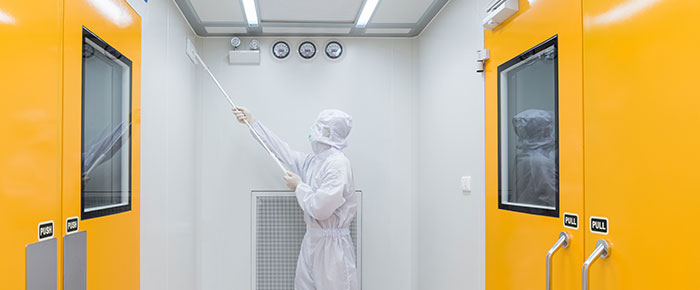
Sterile environments are essential to nearly all biologic laboratories, acting as the first line of defense against contamination buildup when performing cell culture. These environments require high levels of sterility, meaning any identification tools must also remain sterile. Thus, within the last few years, labeling solutions have become tailored for such environments, from basic biosafety cabinets to cleanrooms and sterilization procedures.
Biosafety cabinets
Most personnel working with biologic materials will require, at some point, a biosafety cabinet to maintain a sterile environment while culturing and manipulating cells for experimentation. These cabinets are themselves a specific kind of lab environment that can affect label integrity, as items placed inside are frequently sprayed repeatedly with alcohol to sterilize their surfaces. In some cases, items are even left in the cabinet for an extended period and thus subjected to repeated UV light exposure, a common source of fading for labels.
When working in a biosafety cabinet, it is tempting to merely pick up a marker and write on all tubes and containers. Indeed, using an alcohol-resistant marker can be a quick way of identifying some types of consumables, at least in the short term. For instance, it’s easy to write the date a bottle of media was opened using a marker. However, it is best practice to always print labels that can be neatly affixed to each and every item inside the cabinet, especially for tubes and microplates. Labels should ideally be printed with both barcodes (or RFID) and human-readable information, providing a reliable method of tracking samples, whether they’re inside the cabinet or an incubator. Because alcohol is used so often for sterilization, these labels should be at least partially chemically-resistant. Notably, the printout should also be resistant to alcohols and, if necessary, UV exposure. Thermal-transfer printers are therefore recommended as they provide the optimal protection against these environments, in addition to cryogenic storage, which is useful for samples destined for liquid nitrogen Dewars, such as aliquots of primary cells and prolonged cell line storage.
Label and printer placement is also important to consider prior to working in a biosafety cabinet. For microplates, it is essential to place the label on the side or bottom of the plate so that if a lid is accidentally misplaced, the sample doesn’t risk losing its identity. Labels placed on the bottom should ideally be clear and reverse-printed for easy scanning and legibility. For printers stored in or around biosafety cabinets, it’s essential to keep them free of clutter and ensure they have sealed buttons and wipeable surfaces. Giving a dedicated space to your printer helps avoid dust buildup, thus mitigating the chances of contaminants entering your cabinet and the areas around it. Paper labels and carton cores should also be avoided, as these can lead to a relatively high rate of dust buildup compared to plastic labels and cores.
Cleanrooms
Most of the same labeling principles for biosafety cabinets also apply to cleanrooms, such as those used for IVF laboratories. However, depending on the industry, cleanrooms have their own standards and regulations that must be followed. One of the things that sets cleanrooms apart from basic biosafety cabinets is their restrictions on volatile organic compounds (VOCs). A high amount of VOCs in the air can permanently alter the gene expression and characteristics of many types of cells, including eggs, sperm, and zygotes, making it imperative to limit VOCs throughout the entire lab, not just the biosafety cabinets. In doing so, it is necessary to obtain labels, including cryo straw labels, that have been tested for VOCs to ensure they do not emit prior to entering the cleanroom. Note that toxicity testing should also be performed, such as a Limulus Amebocyte Lysate assay (LAL) to verify the absence of endotoxins along with human sperm motility assays, which are used as a quality control tool to test all types of devices or materials that are usually used in the processing of semen in IVF laboratories. For cleanrooms, it is also vital to utilize dedicated printers that are easy to clean to avoid contamination, along with labels designed for use in sterile environments. Cleanroom labels and tags are made from low out-gassing material, have ultra-low leachables, and low particulates. Each label should also be tested for surface particles, cleaned, and, where possible, individually packaged in a controlled environment.
Sterilization procedures
Sterilization is a necessary component of working in a clean environment, whether you’re using an autoclave to clean pipette tips, tools, microplates, or solutions. In order to properly identify all sterilized items, it is heavily recommended that autoclave labels be affixed to each individual item, as they withstand both the high heat and pressure associated with autoclave sterilization, in addition to gamma irradiation and ethylene oxide. Permanent labels can be used to identify single-use bags and blister packs, while removable autoclave labels are also available, perfect for labeling reusable sterilization containers that will undergo repeated sterilization cycles.
Role of RFID in sterile environments
RFID is an invaluable tool, especially for IVF cleanrooms, where it can be used in a variety of ways to track and trace eggs, sperm, and gametes and mitigate errors. Incorporated into an electronic witnessing system (EWS), RFID can be utilized to verify the identity of every sample, even during immediate use, notifying personnel when the wrong cells are even placed next to each other in the same workspace. RFID can also be integrated into nearly all cleanroom and sterilization procedures. Using technology that outfits labels with an RFID inlay, nearly any RFID label can be generated, from autoclave labels to cryogenic and alcohol-resistant labels. This means that RFID can be customized to fit all sterile environments, regardless of whether the concern is for VOCs or basic bacterial and/or viral contaminants.
LabTAG by GA International is a leading manufacturer of high-performance specialty labels and a supplier of identification solutions used in research and medical labs as well as healthcare institutions.